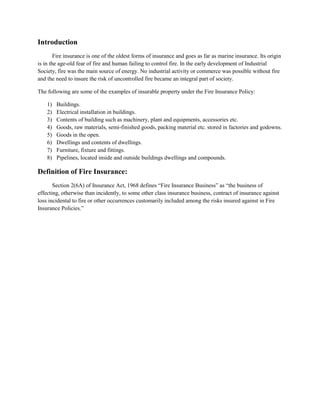Fire insurance
- 1. Introduction Fire insurance is one of the oldest forms of insurance and goes as far as marine insurance. Its origin is in the age-old fear of fire and human failing to control fire. In the early development of Industrial Society, fire was the main source of energy. No industrial activity or commerce was possible without fire and the need to insure the risk of uncontrolled fire became an integral part of society. The following are some of the examples of insurable property under the Fire Insurance Policy: 1) Buildings. 2) Electrical installation in buildings. 3) Contents of building such as machinery, plant and equipments, accessories etc. 4) Goods, raw materials, semi-finished goods, packing material etc. stored in factories and godowns. 5) Goods in the open. 6) Dwellings and contents of dwellings. 7) Furniture, fixture and fittings. 8) Pipelines, located inside and outside buildings dwellings and compounds. Definition of Fire Insurance: Section 2(6A) of Insurance Act, 1968 defines âFire Insurance Businessâ as âthe business of effecting, otherwise than incidently, to some other class insurance business, contract of insurance against loss incidental to fire or other occurrences customarily included among the risks insured against in Fire Insurance Policies.â

